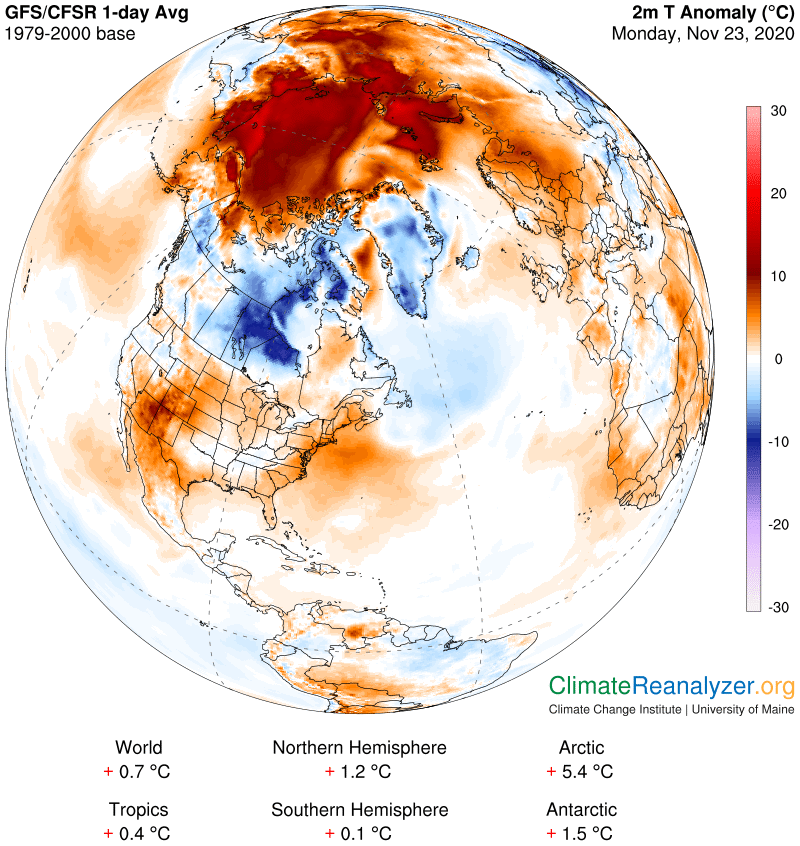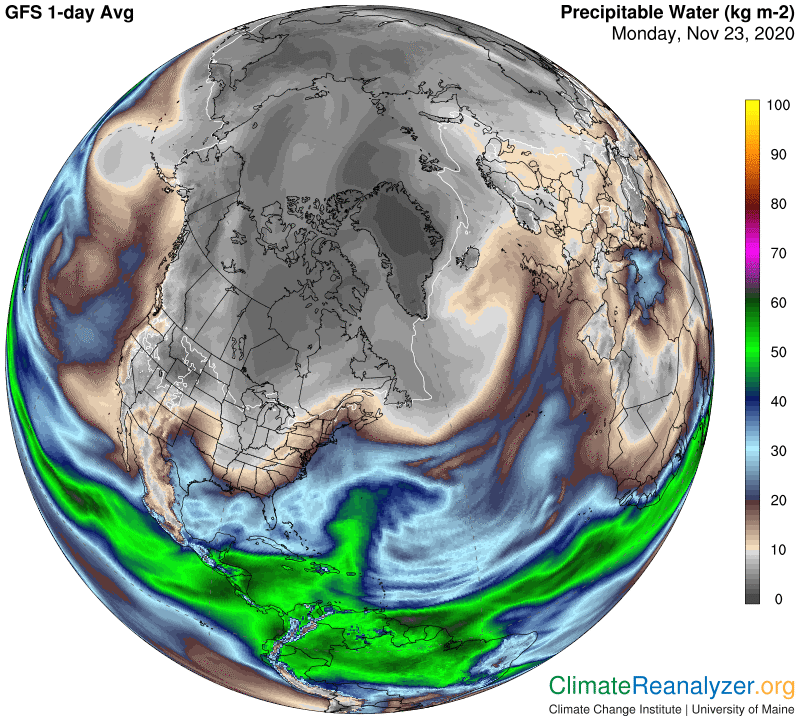Another weekend of intense warming of the air over the Arctic Ocean brings us to the end of two full months without a break. The daily average for the anomaly over the entire ocean for the entire period could probably be calculated. I won’t try, but I think it would be scary. When you look at today’s image you see almost nothing under 5C, relatively little under 6C, and a whole lot that is more than 10C. Some of the warmest part is being considerably amplified, day after day, by radiation coming directly from waters that have not frozen like they did during the baseline period. One of the most interesting things about ice is its power of insulation. As an illustration, a sheet of ice no more than eight or ten feet thick will protect the water below from getting any colder even when the air above is ranging up to 50C (90F) colder than the water for months on end, as it can during a severe Arctic winter. So far, this still-early winter is not the least bit severe, but it is still cold enough for sea ice to slowly continue expanding, and even the thinnest new layer will effectively start insulating while it thickens.

At this time of year things like sunlight and cloud cover have little or no effect on air temperatures. CO2 maybe? This year its concentration is about 15% higher than it was during the baseline period, which will make the air warmer, but not much, atually just a small fraction of one degree. The same can be said for the energy effect of additional methane and all the other greenhouse gases, except for one, water vapor. Water vapor has greenhouse effects that are similar to the others in terms of blocking radiation, which notably make it the most powerful of all, but is otherwise entirely different from the rest. The biggest difference of all is in distribution. Every other greenhouse gas tends to become evenly distributed in all parts of the atmosphere as a percentage of air composition, from ground level up to the stratosphere and beyond, and tends to stay that way as long as possible. Thus, the total amount of each of these gases shows only a little change from one year to the next as a percentage of air composition. CO2 for example, even as its content accelerates, is growing at a rate of only about 6/10 of one percent per year.
What makes water vapor different from the others has little to do with overall rate of growth in total atmospheric content, which at best can only be roughly estimated, and a whole lot to do with the way that content is distributed, which is irregular to an extraordinary extent. On this very day, the total amount, by weight, within a vertical column of air to the top of the atmosphere, per square meter, ranges from about 500 grams to just under 70 kilograms. Other days may go from just 25 of the one to 75 of the other, for an amazing proportion of 3000 to one—on the same day, no less. That is how water vapor is distributed in bodies of air over horizontal surfaces, with the lowest numbers tied to either polar or highly elevated surfaces (Antarctica has both, and Greenland too) and the highest to oceanic surfaces in the tropics. Particular locations in any part of the globe do not change a great deal, over any period of time, in terms of units of overhead water vapor, but when you look at water vapor changes in terms of percentages rather than units there are commonly observed corresponding changes on the temperature side that tend to be dramatic.
The way all greenhouse gases go about their work of blocking the passage of radiating energy is quite special. The more molecules there are of any one gas in the atmosphere the less effective they become, per molecule. It’s as if they were getting in the way of each other so they can’t block as well. The result, which is widely assumed if not too well studied for every kind of gas, is that the net effect on energy movement of any one double of atmospheric concentration of that gas will be the same for the next double, and the one after that, etc. Each such change in energy movement will then be matched by a fixed change in air temperature at the low point of the column, regularly repeated. Thus any doubling of CO2 in the air above, strictly by virtue of its own molecular self, will by all calculations raise the surface temperature by about 1.2C. When you hear of higher numbers the reason is always due to arbitrarily combining the effect of CO2 with the net effect of numerous other forces that influence temperatures, some of which, but not all, may be other greenhouse gases. Water vapor is always included with the other things, and usually kept completely out of sight. No scientific study that I know of has come to a conclusion about how much the temperature will increase if or when the overhead content of water vapor doubles and everything else remains exactly the same.
I keep saying the right answer should be about 10C per double, and that’s all because I see evidence in support of this number every day when studying the weather maps. As reported and illustrated here on many occasions, the lowest amounts of ambient water vapor, those that naturally exist in or near the polar regions, are the easiest ones to double or even redouble whenever significant inputs of water vapor are added to the overhead atmosphere for even a short period of time. Today’s map, when closely matched with the one at the top, has more examples of this very thing happening.

Carl